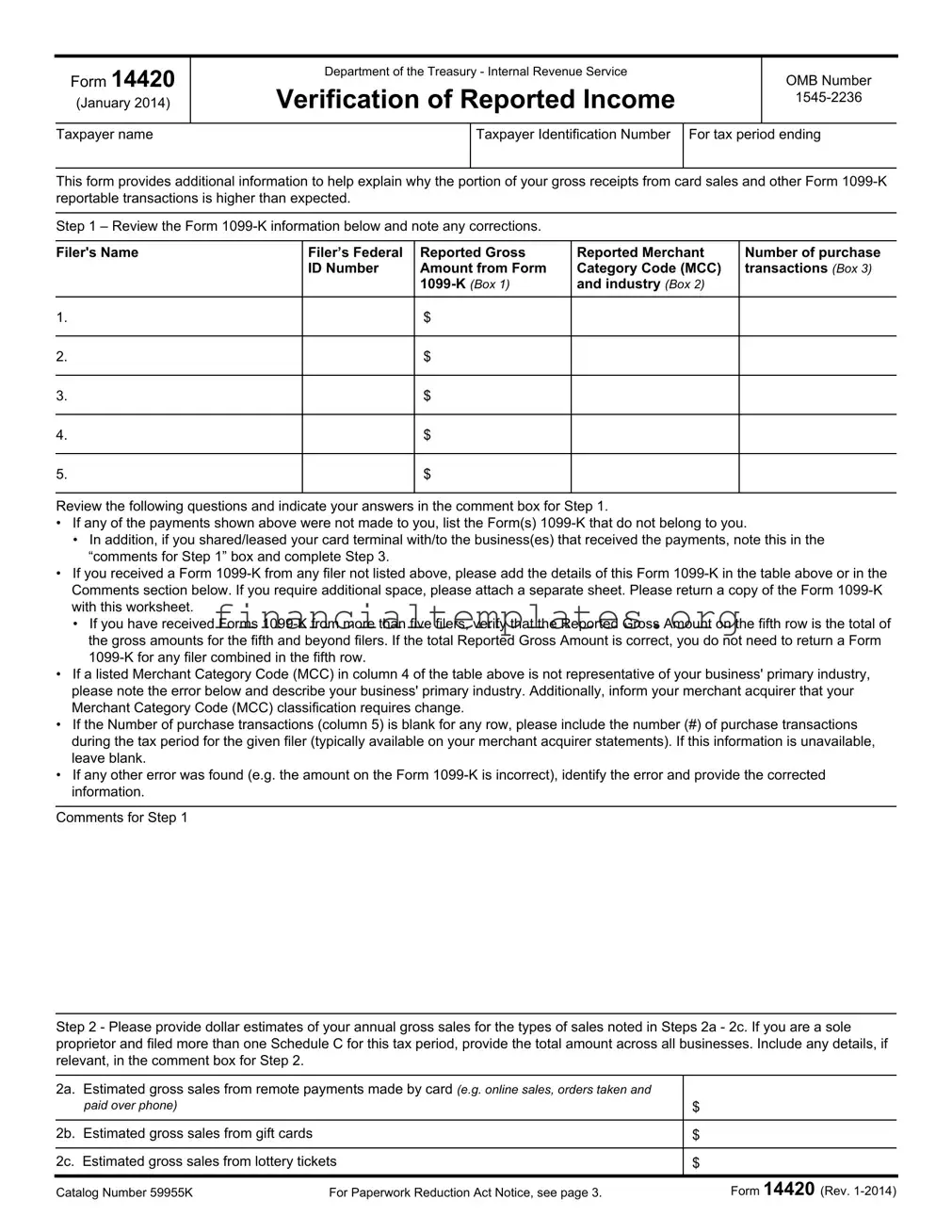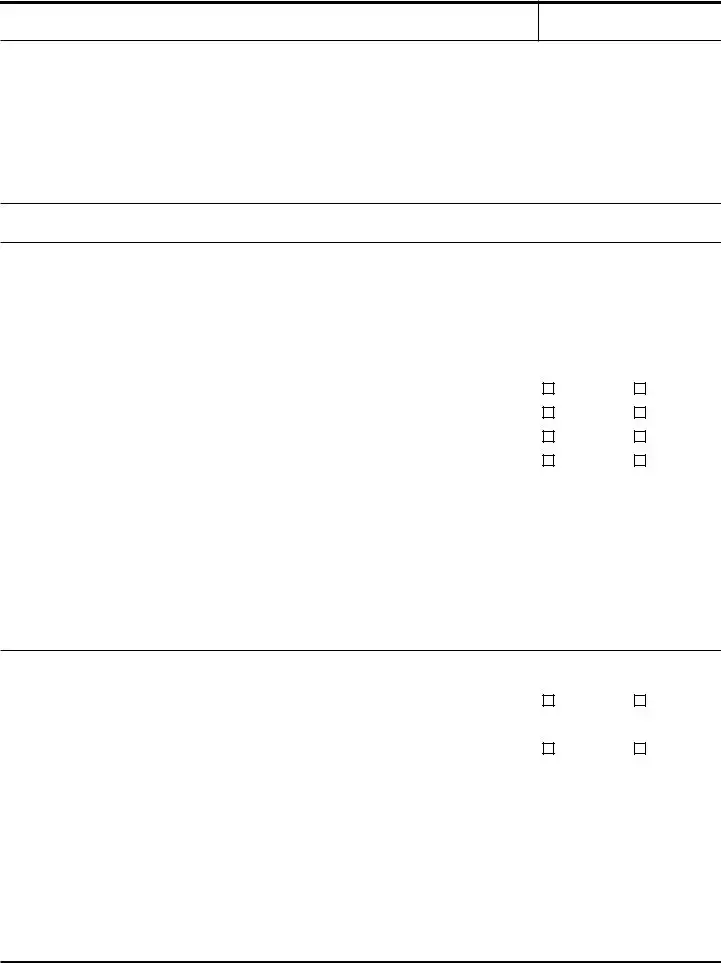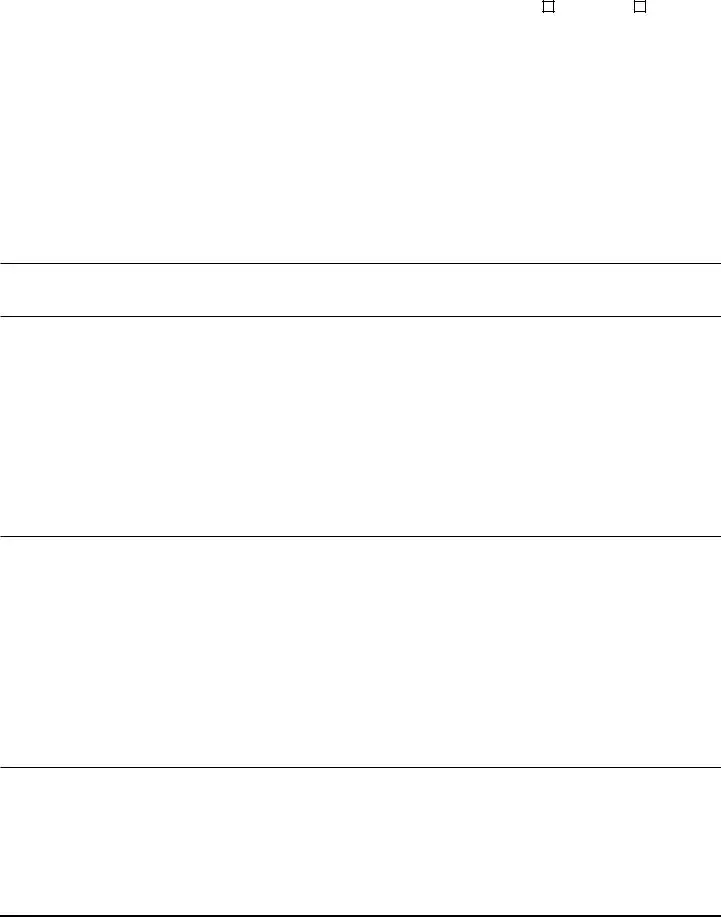Page 4 of 4
Instructions for Form 14420, Verification of Reported Income
Form 14420 asks you to provide information that may explain why the portion of your gross receipts from card sales and other Form 1099-K reportable transactions is higher than expected.
Please complete Form 14420 in its entirety and return it within the timeframe noted in the accompanying letter.
Step 1:
Important: Note that for filers of Forms 1120, 1120-S, and 1065, all Form 1099-K information captured in Step 1 should correspond ONLY to the business with the EIN identified at the top of Page 1. For individual Form 1040 filers however, the Form 1099-K information captured in Step 1 should correspond to all sole proprietorships (i.e., Schedule Cs) filed with the Form 1040. This should include Forms 1099-K with different Taxpayer Identification Numbers (e.g., a spouse’s SSN or EIN) that relate to sole proprietorships for which a Schedule C was filed with the return. If an individual tax return filer is also a partner or shareholder in a partnership or S-Corp, Forms 1099-K related to those entities should not be included on Form 14420.
In this step, review the information from each Form 1099-K in the table and identify any errors.
If any of the payments shown were not made to you, list the Form(s) 1099-K that do not belong to you. If you shared/leased your card terminal with/to business(es) that received some or all of the payments captured on these Form(s) 1099-K, note this in the “Comments for Step 1” box provided and complete Step 3.
If you received a Form 1099-K not listed above, please add the details of the Form 1099-K to the table above or in the “Comments for Step 1” box. If you require additional space, please attach a separate sheet. Please return a copy of the Form 1099-K with this worksheet. If you have received Forms
1099-K from more than five filers, verify that the Reported Gross Amount on the fifth row is the total of the gross amounts for the fifth and beyond filers. If the total Reported Gross Amount is correct, you do not need to return a Form 1099-K if the information is combined in the fifth row.
If a listed Merchant Category Code (MCC) in column 4 of the table above is not representative of your business' primary industry, please note the error below and describe your business' primary industry. Additionally, inform your merchant acquirer that your Merchant Category Code (MCC) classification requires change.
If the Number of purchase transactions (column 5) is blank for any row, please include the number (#) of purchase transactions during the tax period for the given filer (typically available on your merchant acquirer statements). If this information is unavailable, leave blank.
If any other error was found (e.g. the amount on the Form 1099-K is incorrect), identify the error and provide the corrected information.
Step 2:
In this step, provide dollar estimates of your annual gross sales from each of the types of sales noted in Steps 2a – 2c. For Step 2a, please note that you should only include sales from remote payments made by card (e.g. online sales, orders taken and paid over phone).
If you are a sole proprietor and filed more than one Schedule C for this tax period, provide the sum of these dollar amounts across all of your businesses.
Provide comments as necessary in the “Comments for Step 2” box.
Step 3:
Only complete this step if you shared/leased your card terminal(s) with/to other persons or businesses at some time during the tax period. In the table provided, list the names, taxpayer identification numbers, and dollar amounts of payment card receipts attributable to these persons or businesses. Also indicate whether or not you filed a Form 1099 (i.e., a Form 1099-K or a Form 1099-MISC) for these persons or businesses. Use the “Comments for Step 3” box or a separate sheet to provide a brief explanation of how these persons or businesses are related to your business.
Note: If you shared/leased your card terminal(s) with more than four other persons or businesses, provide details on the fifth and subsequent persons/ businesses in the “Comments for Step 3” box or on a separate sheet.
Step 4:
In Steps 4a and 4c, indicate whether you included sales tax and merchant acquirer fees, respectively, in the Gross Receipts line reported on your tax return. If you included them in your Gross Receipts, please provide the total sales tax and merchant acquirer fees paid in the tax period in Steps 4b and 4d, respectively. If you are unsure of the merchant acquirer fees paid in the tax period, please estimate the total fees and include in the comment box an explanation.
Include an explanation, if necessary, in the “Comments for Step 4” box.
Step 5:
In this step, indicate whether your business has a website, and if so, provide the web address in the row just below the prompt and a brief description of your online business in the “Comments for Step 5” box. Please describe the nature of your online business and describe the goods and services that you sell online.
Step 6:
In this step, provide any other information to explain why the gross receipts reported on your tax return are lower than expected based on your card payments and other Form 1099-K reportable transactions. Take care to explain why the amount of non-card sources of income, including cash and checks, as a portion of your gross receipts may be lower than expected for your type of business. A comment box is provided to capture this information. If additional space is required, please attach your response on a separate sheet.
Step 7:
In this step, provide the taxpayer’s/officer’s contact information, including name, title, telephone number(s), and contact hours. If the contact person is not the taxpayer or an officer of the business and a valid Form 2848, Power of Attorney and Declaration of Representative, has not previously been submitted, please include a signed Form 2848 with your response.




